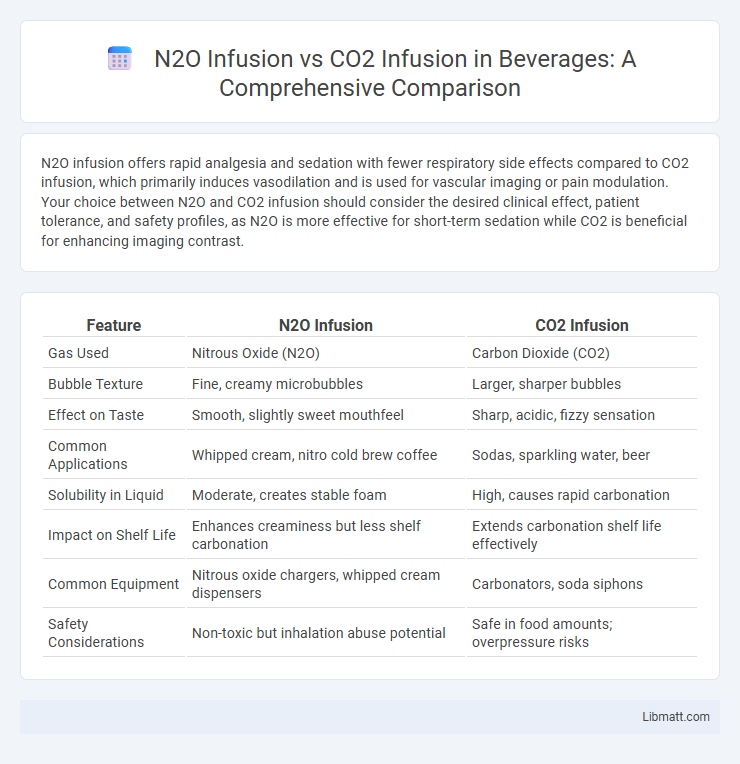N2O infusion offers rapid analgesia and sedation with fewer respiratory side effects compared to CO2 infusion, which primarily induces vasodilation and is used for vascular imaging or pain modulation. Your choice between N2O and CO2 infusion should consider the desired clinical effect, patient tolerance, and safety profiles, as N2O is more effective for short-term sedation while CO2 is beneficial for enhancing imaging contrast.
Table of Comparison
| Feature | N2O Infusion | CO2 Infusion |
|---|---|---|
| Gas Used | Nitrous Oxide (N2O) | Carbon Dioxide (CO2) |
| Bubble Texture | Fine, creamy microbubbles | Larger, sharper bubbles |
| Effect on Taste | Smooth, slightly sweet mouthfeel | Sharp, acidic, fizzy sensation |
| Common Applications | Whipped cream, nitro cold brew coffee | Sodas, sparkling water, beer |
| Solubility in Liquid | Moderate, creates stable foam | High, causes rapid carbonation |
| Impact on Shelf Life | Enhances creaminess but less shelf carbonation | Extends carbonation shelf life effectively |
| Common Equipment | Nitrous oxide chargers, whipped cream dispensers | Carbonators, soda siphons |
| Safety Considerations | Non-toxic but inhalation abuse potential | Safe in food amounts; overpressure risks |
Introduction to Gas Infusion Techniques in Medicine
Gas infusion techniques in medicine utilize N2O and CO2 for distinct therapeutic and diagnostic purposes. N2O infusion is commonly employed for analgesia due to its rapid onset and minimal respiratory depression, enhancing patient comfort during minor procedures. CO2 infusion is primarily used in laparoscopy to create pneumoperitoneum, offering superior visualization with its rapid absorption and low risk of gas embolism compared to alternative gases.
Understanding N2O Infusion: Mechanism and Applications
N2O infusion operates by delivering nitrous oxide gas directly into the bloodstream, where it acts as a potent analgesic and anxiolytic through modulation of NMDA receptors and release of endogenous opioids. Unlike CO2 infusion, which primarily influences respiration and acid-base balance, N2O infusion provides rapid onset sedation and pain relief, making it valuable in medical, dental, and psychiatric procedures. Clinical applications of N2O infusion include procedural sedation, refractory depression treatment using psychotropic protocols, and as an adjunct to anesthesia for enhanced patient comfort.
Exploring CO2 Infusion: Mechanism and Applications
CO2 infusion enhances soil aeration by increasing carbon dioxide levels, which stimulates root respiration and microbial activity, improving nutrient uptake. In medical treatments, CO2 infusion promotes tissue regeneration and wound healing through vasodilation and increased oxygen delivery. Compared to N2O infusion, which primarily acts as an anesthetic and analgesic, CO2 infusion's mechanism centers on physiological stimulation rather than sedation.
Key Differences Between N2O and CO2 Infusion
N2O infusion delivers nitrous oxide gas directly, producing rapid analgesic and anxiolytic effects with mild euphoria, while CO2 infusion involves carbon dioxide, primarily used to induce hypercapnia for diagnostic or therapeutic purposes. N2O acts quickly on the central nervous system by inhibiting NMDA receptors, whereas CO2 influences respiratory drive and cerebral blood flow by altering blood pH and CO2 levels. The distinct pharmacodynamics and physiological impacts highlight N2O's preference in dental sedation versus CO2's role in respiratory and cerebrovascular testing.
Clinical Benefits of N2O Infusion
N2O infusion provides rapid analgesia and anxiolysis, enhancing patient comfort during minor procedures with minimal respiratory depression. Unlike CO2 infusion, N2O offers a faster onset and offset, allowing for better control during sedation and quicker recovery times. Your clinical outcomes improve with N2O's ability to reduce procedural stress and maintain hemodynamic stability more effectively than CO2.
Clinical Benefits of CO2 Infusion
CO2 infusion offers significant clinical benefits over N2O infusion, including enhanced tissue oxygenation and faster elimination through respiration, which reduces the risk of gas embolism and postoperative complications. Unlike N2O, CO2 is more soluble in blood, minimizing the chances of air trapping and enhancing patient safety during laparoscopic procedures. Your surgical outcomes improve with CO2 infusion due to better cardiovascular stability and reduced postoperative pain.
Safety Profiles: N2O vs. CO2 Infusion
N2O infusion is generally associated with a favorable safety profile due to its rapid onset and clearance, minimal respiratory depression, and analgesic properties, making it suitable for short procedures. In contrast, CO2 infusion carries risks such as hypercapnia and acidosis if not carefully monitored, but is preferred in procedures requiring rapid tissue absorption and minimal gas embolism risk. Clinical studies indicate N2O's safety advantage in controlled environments, while CO2 infusion demands strict monitoring to mitigate potential complications during extended or higher-volume administration.
Patient Outcomes and Satisfaction
N2O infusion provides faster onset and recovery times compared to CO2 infusion, leading to improved patient comfort during procedures. Studies show higher patient satisfaction scores with N2O due to reduced anxiety and pain perception. Your choice of sedation method can significantly impact overall patient experience and procedural outcomes.
Current Guidelines and Best Practices
Current guidelines recommend CO2 infusion over N2O infusion for endoscopic procedures due to CO2's faster absorption and lower risk of gas embolism. Best practices emphasize monitoring insufflation pressure to minimize patient discomfort and reduce complications associated with CO2. Data indicates that N2O infusion presents higher risks of diffusion hypoxia and prolonged elimination times, making CO2 the preferred gas in clinical settings.
Future Trends in Medical Gas Infusion Technologies
N2O infusion systems are evolving to offer enhanced analgesic control and quicker onset times compared to traditional CO2 infusion methods, driven by advancements in precision dosing technology. Emerging trends include integration with smart monitoring devices that optimize gas delivery based on real-time patient feedback, improving safety and efficacy in clinical settings. Your choice between N2O and CO2 infusion may increasingly depend on these innovations, which aim to personalize treatment and minimize side effects.
N2O infusion vs CO2 infusion Infographic

 libmatt.com
libmatt.com